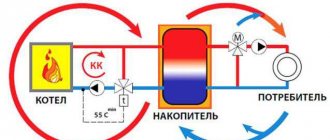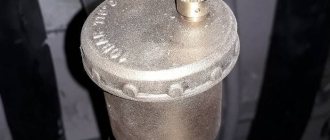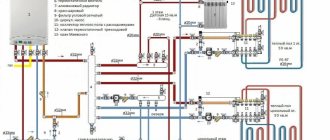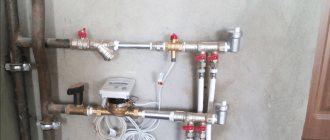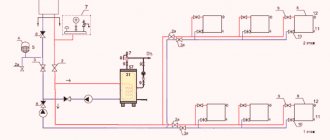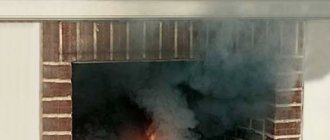The house still smells like a fresh renovation, but the heating radiators are no longer working as well as you would like? What is the problem, why are not all sections heated, or is the battery only heated in the upper part, and is it cold at the bottom?
All heating batteries are completely new, but the efficiency of the heating system leaves much to be desired.
Such problems can befall both owners of luxury cottages and residents of ordinary country houses and apartments.
Those who encountered this problem in the autumn were also lucky, when the outside air temperature was not yet too close to zero. In this case, there is a small amount of time left to carry out routine diagnostics and repairs.
What should those “lucky ones” do, whose radiator stopped warming up right in the Epiphany frosts or even on New Year’s Eve? Then they have to spend the entire New Year holidays looking for a sober plumber. And it’s good if these searches are crowned with success.
Did the unexpected appearance of these symptoms seem like the worst disaster to you? In fact, the lack of obvious prerequisites for this is the main problem!
And in this case it has to be solved through trial and error.
Of course, it is impossible to reduce the probability of suddenly losing heating to zero, but you definitely need to know the main reasons that contribute to the transformation of your home into the residence of Santa Claus.
Signs of poor heating
The first sign of heating problems is cold radiators.
When rooms are not heated enough in winter, you can feel it right away. Problems with heating in an apartment make themselves felt by discomfort for the inhabitants, the appearance of dampness on the walls and strange noises spreading through metal pipelines throughout the entire house.
Problems that arise with the heating system can be characterized by a number of symptoms:
- the system as a whole is functioning poorly;
- the heat supply on different floors is not the same;
- radiators in one room are hot, in another barely warm;
- the “warm floor” system warms up unevenly;
- noise and seething in the pipes is heard;
- Coolant is leaking from pipes or radiators.
Causes of heating problems
Most residents of city apartments believe that they have no need to know the structure of engineering systems. Any central heating problems that arise in their high-rise building must be resolved by the employees of the management company. And it is right. It is better if only one responsible owner is involved in all matters. Indeed, in an apartment building, problems with heating often arise precisely because of unauthorized interventions in the smooth functioning of the heating system.
But individual homeowners are forced to understand problems with heating in a private home and keep the situation under control. The owner of the house must know at least in general terms about the causes of problems and be able to correct them.
The following reasons can lead to problems with the heating system:
- the system is not properly designed;
- equipment does not meet design requirements;
- the system was unbalanced due to unauthorized connections;
- installation was performed poorly;
- air pockets interfere with coolant circulation;
- radiators are installed incorrectly;
- pipelines have become unusable;
- the tightness of the connections is broken.
Let's take a closer look at each of these reasons and ways to eliminate heating problems in an apartment and in a private house.
Scheme of consumer actions if the radiators in his apartment do not heat
If, after the start of the heating season, the radiators in an apartment or house do not heat well, where can I complain? First of all, to a company that provides heat supply to a residential building. Its technical staff are required to inspect the problem area and record temperature readings. Based on the data received, an act is drawn up. If no action is taken to resolve the problem within 3-7 days, the consumer has the right to file a claim. The video will help you understand the nuances of the issue in more detail:
We are all very familiar with the situation when, in our own apartment, with the onset of cold weather, we are forced to take out extra blankets, warm clothes and use electric heaters for heating. The reason for this situation is trivial - the disgusting quality of heating of residential premises. In a number of situations, this state of affairs is temporary, falling during the off-season. However, sometimes the quality of heating in apartment buildings throughout the winter leaves much to be desired. Who is responsible for heating in our apartments? Where to look for the last resort and what to do? We will try to answer these and other related questions.
Let's start with the official documents “technical operation of housing facilities”, section II states that the responsibilities for maintaining communication systems in residential buildings are assigned to the Management Company. Its scope of tasks and responsibility includes ensuring the normal operation of heating systems of residential buildings, sewerage and water supply systems. This standard was approved by Decree of the State Construction Committee of the Russian Federation No. 170 of September 27, 2003. Therefore, if your house is serviced by a management company, all questions regarding the normal operation of the heating should be directed to it.
The organization that owns your home is responsible for maintaining normal temperature conditions in the rooms covered by the centralized heating system. The management company is also responsible for controlling the temperature of the coolant at the outlet (return).
This also includes control over the technical side of the issue. Assessing the condition of utility networks, carrying out scheduled routine maintenance and inspections in order to identify technical non-compliance of common property with established standards - all this and much more is included in the responsibilities of the management company.
Inspection of the central heating system is carried out by a specialist whose responsibilities include eliminating detected malfunctions in the heating operation, as well as preventing cases of excessive heat consumption in a residential property. Such an inspection is carried out, as a rule, once a year. Based on the inspection results, appropriate repair work is carried out and adjustments are made to prepare the residential building for the next heating season.
Evaluating the above, and fixed at the regulatory level, it is clear who is responsible for the condition of the heating networks in a residential building and whose competence includes organizing the normal operation of the heating system directly in the house. Thus, all responsibility for the proper condition of the common property to you and the residents of other apartments in your building rests with the management company or housing office, with which you have a very warm and difficult relationship.
Out of habit, when the heating system does not work, we blame the energy company that supplies heat to residential buildings. Few of us think that the supplier company is responsible for the temperature of the coolant, which must comply with established standards, for normal operating temperatures in the mains. The utility company's responsibility extends to the functionality of the backbone networks to the point where your home is connected. Then the management company or housing office is responsible for the heat in your home.
Options are possible when the temperature of the coolant is not sufficient for normal heating of residential premises, and there are interruptions in turning on the centralized heating within the prescribed time frame. In these cases, responsibility falls entirely on the energy company supplying heat to your apartments.
Errors in heating system design
The design of the heating system must be developed taking into account the layout of the house.
Due attention must be paid to the development of the heating system project so that in the future the problems of heating a private house do not poison everyday life. Attempts to save money on proper design result in trouble. For example, when starting up a fully installed system, problems with heating radiators are suddenly discovered, some of which do not heat up. This means that the system was initially designed incorrectly and will have to be redone.
Design can only be entrusted to specialists who will take into account many factors. Among them: the layout of the house, the volume of heated premises, the degree of heat loss, etc. It is also important to plan the required slope of horizontal sections of pipelines. Also, the main technical parameters of the required equipment can only be determined on the basis of thermal engineering calculations.
To reliably heat a house, the heating boiler must have a power of at least 1 kW for every 10 m² of room area with a ceiling height of up to 3 m.
Inappropriate home heating equipment
Its performance will depend on the correct choice of materials for the heating system.
With the current wide range of heating equipment, it is easy to make a mistake and purchase the wrong one. To avoid problems in the heating system, it is necessary to focus on the compliance of all its elements with the approved project. You need to buy radiators only of the type and with the number of sections as planned. All pipeline connecting parts, control and shut-off valves must be mutually compatible.
Heating problems in a private home often arise due to poor circulation. Circulation pumps help increase the speed of coolant movement in the pipes. But you need to select the right pump model correctly so that there is no noise in the pipes during its operation.
When arranging modern housing, old iron pipes are increasingly being replaced by more practical metal-plastic and polypropylene pipes. The absence of problems in each specific heating system will depend on their compliance with the specified project conditions. Although plastic pipes are lightweight and easy to assemble, it is better to entrust a specialist with the correct selection and subsequent installation of these products.
It is important to know that not all types of plastic pipes are suitable for heating systems. Some of them may become deformed or burst under the influence of hot water.
Coarse filter
As mentioned above, one of the reasons that there is no coolant circulation may be the accumulation of debris in the pipeline. To completely avoid this, again, we don’t save on pennies, but install a coarse filter in front of each device:
Using a filter, catching dirt is easier than correcting the consequences of clogged pipelines or boiler heat exchangers.
Conclusion! We place coarse filters in front of each heating system device (pump, boiler, etc.) and in front of each plumbing fixture. We do NOT save pennies to “buy” problems. There are arrows stamped on the filter housing indicating the direction of movement of the coolant or water in the water supply...
The filter needs to be cleaned regularly. And this is very simple to do: close the valves before and after the filter - unscrew the plug (1) on the filter - remove and rinse the mesh under the tap - put it in place and tighten the plug. All. Not like changing pipes
These are the simple “body movements” you need to perform in order to never complain that there is no circulation in the heating system. Good luck.
no circulation in the heating system
The return in the heating system is the coolant that has passed through all the heating radiators, lost its primary temperature and is now cold and supplied to the boiler for the next heating. The coolant can move in both a two-pipe and an improved single-pipe heating system.
A single-pipe system implies a sequence of connections of heating radiators. That is, the supply pipe is connected to the first radiator, from which the next pipe goes to the second radiator, and so on.
If a one-pipe heating system is improved, its design will be something like this: along the perimeter of the entire room there is one pipe into which the supply and return pipes of each radiator can be inserted. In this case, it is possible to install a control valve on each battery, with which you can very successfully regulate the air temperature in a given room.
The big advantage of this option is the minimal number of pipes in it. And the minus is the temperature difference between the first radiator from the boiler and the last. This problem can be eliminated with the help of a circulation pump, which will move all the water through the heating system much faster, and thus the coolant will not have time to reduce the temperature.
The two-pipe option represents the wiring of two pipes. One pipe is the supply of hot coolant, the second pipe is the return pipe in the heating system, through which already cooled water from the radiators enters the boiler. This system allows you to connect all radiators almost in parallel, which allows for flexible configuration of each radiator individually without affecting the operation of the others.
Heating system imbalance
Serious problems with heating in an apartment building arise when residents begin to repair and remodel their apartments. Spontaneous, uncontrolled installation of new radiators and heated floors leads to an imbalance in the system. As a result, circulation in the system is disrupted; on some floors the radiators are hot, while on others the residents are cold. The management company’s specialists can balance the distribution of coolant through the risers, but problems with heating in individual apartments still remain.
If your neighbors changed their heating appliances and removed their thermostats, then it is not surprising that water simply will not flow through the pipes into your apartment. And it will be possible to solve such a heating problem only by removing the thermostat in your home as well.
Another opportunity to really increase the heat supply to your apartment is to follow the example of your neighbors and change the batteries. If you install aluminum or bimetallic instead of cast iron, their heat transfer will be much better.
It is prohibited to change radiators without permission; you must obtain permission!
The heating system can also become unbalanced in a private home. Then radiators located closer to the boiler heat up more than those further away. The balance will have to be restored in this way: close the control taps and limit the flow of coolant flowing to the nearby radiators, so that more heat flows to the distant ones.
Problems with the heating circuit
The pump must be selected according to the requirements of the heating circuit.
Malfunctions in the operating mode of the heating circuit are not always associated with a malfunction of the main heating element. If the boiler works, but does not heat the batteries, the reason must be sought in the wiring itself.
List of main heating circuit malfunctions:
- the filter on the return line or the needle tap (Maevsky tap) is clogged;
- insufficient power of the circulation pump;
- the rules for installing a heating circuit with natural circulation have not been followed.
Any of the above problems must be resolved before the start of the heating season. Otherwise, the room may be left without heat for several days, since the repair involves completely draining the coolant.
So, why doesn’t the boiler heat the batteries if everything worked fine over the previous years? The reason is a dirt plug that has formed on the heating circuit filter and completely blocks the coolant flow. It can be solved simply - the water is drained from the pipes or its circulation is blocked using bypasses, and the filter is cleaned. To prevent a similar situation from reoccurring, it is necessary to completely replace the coolant with a parallel one.
In a gravity system, the slope of the pipes is key.
The second reason why the boiler works but the radiators are cold is the insufficient power of the circulation pump. The performance of the device is not enough to pump the entire volume of coolant in a timely and efficient manner. Or the heating system in the house has branches that are located at a significant distance from the pump. As a result, the circulation pump overheats, the heating equipment operates with excessive energy consumption, and the radiators remain cold. The solution is to change the coolant pumping device to a more powerful one.
If the house has a two-pipe heating circuit with natural circulation of water, and during the heating season it is often noticed that the boiler is on and the radiators are cold, then the reason lies in non-compliance with the slope of the main line. According to regulatory documentation, only a pipe slope of 10 mm per linear meter in a heating system with natural circulation will ensure normal coolant movement. The result is uniform heating of the batteries throughout the house. If there is no slope, the coolant stagnates, which negatively affects the temperature of the radiators. The problem can be solved by completely redoing the wiring.
Poor quality installation of the heating system
A poorly installed plastic pipe may burst during operation.
It happens that a new, recently installed radiator does not want to heat up.
Others in the system before and after it heat up normally, but this one does not. The reason is poor coolant circulation. The reason for the problem with the heating radiator could have been an oversight by the installer. Probably, when welding a polypropylene pipe, he overheated it too much, and as a result of melting, the internal diameter decreased. In such cases, the installer is obliged to redo his poor-quality work free of charge.
To avoid problems with the heating system, all pipes and fittings included in its composition must be a securely installed structure.
Equipment and materials for DIY work
Having decided to repair the heating yourself, you need to properly and competently prepare for this event.
To work you will need the following tools:
- grinder, hammer drill, soldering iron for plastic pipes, screwdriver, welding machine;
- tape measure, square, level;
- plumbing pliers, adjustable gas wrench, core;
- devices for cutting internal and external threads;
- hammer;
- cable with brush;
- ladder;
- marker.
Tools are selected depending on the volume of expected work.
The list may be larger or smaller depending on the type and volume of the upcoming repair. To protect the skin, vision and breathing, it is recommended to use goggles, gloves and a gauze bandage.
List of required materials:
- pipe clamps;
- sandpaper;
- cold welding;
- tow;
- FUM tape;
- acetone;
- rags.
Since some of the water in the system will remain after draining, you need to prepare buckets and basins for emptying radiators, and rags to collect spilled liquid from the floor.
Air locks in heating
Automatic air vents free the system from air that periodically accumulates in it.
If the radiators are not heated in any of the rooms, it means that the air accumulated in the system is preventing the free movement of the coolant. An air lock can form due to many reasons, including the following:
- air enters when water is drained from the system and then refilled;
- Oxygen is released from water when heated;
- a faulty expansion tank creates a local area of low pressure;
- air is sucked into the system through connections with broken seals;
- air diffusion occurs through the surfaces of plastic pipes.
Air bubbles can accumulate either at the highest point of the piping system, or only in one of the radiators. Then the bottom of the battery will be hot and the top will remain cold. The presence of air in the pipes also provokes the appearance of unpleasant gurgling sounds. Most often, heating devices on the top floor of a building stop heating.
The more complex the configuration of the heating system in your home, the slower it should be filled to avoid air locks.
Due to air bubbles, not only does the heat supply through the piping system stop, but also corrosion of metal elements begins. The smooth operation of the circulation pump is also disrupted.
The use of simple technical devices will help get rid of the problem of clogging the heating system with air locks.
The most effective way to remove air from a closed heating system is to use automatic air vents. If they are mounted in several problem areas at once, then the air from each group of system elements will be released as it accumulates.
In addition to automatic ones, there are also manual air vents (Maevsky valve). Such a device is installed at the end of the radiator, located on the topmost floor. You can learn how to use it from the video presented here.
How to bleed air through the Mayevsky tap
Depending on how the heating system is designed, it may sometimes be necessary to bleed air through an expansion tank in the attic. The circulation pump can also help expel air pockets from the system.
Features of equipment repair
Repairing heating equipment requires a responsible approach.
Gas boiler repair
The gas boiler is the main and most complex element in the entire heating system of a private home. Automation of this equipment is proceeding at such a pace that even specialists do not have time to keep track of all the innovations. Nevertheless, primary diagnostics and elimination of minor faults can actually be done with your own hands.
Photo 2. The process of repairing a gas heating boiler. Work must only be carried out by a qualified specialist.
Most boiler problems that you can fix yourself are described in the equipment data sheet.
Boiler breakdowns that can be repaired independently:
- Malfunctions of the boiler caused by voltage fluctuations in the electrical network. To eliminate this, connect the boiler through a stabilizer or uninterruptible power supply.
- The pressure has dropped, the boiler has stopped and will not turn on. The pressure in the system is raised to normal by opening the water supply tap.
- Boiler shutdown due to overheating. The heat exchanger is clogged on the outside. It will help to completely de-energize the heating device and clean the heat exchanger with a brush and vacuum cleaner.
Important! the cleaning of parts inside the boiler to professionals!
- The AGV turns off after 2-3 minutes of operation and does not turn on until it cools down completely. The chimney is clogged. It is recommended to clean the ventilation duct.
- Water is leaking from the gas water heater. To solve the problem, all pipes and clamps inside the boiler are inspected and the leak is eliminated.
Attention! It is important to remember that faulty gas equipment poses a potential danger. Therefore, the main thing is to contact specialists in a timely manner and eliminate any problems that arise.
Correction of pumping equipment
Home heating systems use circulation pumps. These devices are divided into two types: monoblock and collapsible.
If you use a model consisting of separate blocks, then sometimes it is possible to repair it yourself.
Malfunctions of pumping equipment that can be eliminated independently:
- The pump hums, the impeller does not rotate. It is advisable to disassemble the pump, rotate the rotor and, if possible, clean accessible parts from oxidation. Sometimes the cause of such a problem lies in a foreign object that has gotten inside.
- The pump does not hum, nothing rotates. It is recommended to look for the fuse. If it is not there, then it is time to change the pump.
- The pump makes a lot of noise when turned on. There is a large amount of air in the pipes. To troubleshoot problems, open the water make-up valve and bleed air from the boiler.
- The pump stops a few minutes after starting and does not produce enough pressure. Scale or other obstructions have formed on the pump cover, interfering with normal operation. The solution to the problem is to remove and clean the cover.
Pipe replacement
Repair work to replace pipes is carried out during the process of major re-equipment of the heating system. When installing new pipes, the following rules are observed:
- Before starting work, it is advisable to turn off the water in the house.
- The water from the heating system is completely drained before dismantling the old equipment.
- Taps are provided for each battery. The necessary fittings are calculated and prepared in advance.
- The pipes are placed at some distance from the floor and walls to make working with them convenient.
Photo 3. Installation of heating pipes made of polypropylene. A special laser is used for marking.
Incorrectly installed heating radiators
The absence of heating problems depends on the correct installation of radiators.
The issue of correct installation of radiators is most relevant for private homeowners, since they themselves have to regulate the heating in their home. Replacing radiators yourself should be treated with responsibility, because installing them without preliminary calculations can add unnecessary problems to the heating system.
For example, the installation was done according to the instructions, but some of the radiators are working at half capacity. It turns out that it is skewed and the coolant cannot fill it entirely. And the reason is that the heavy multi-section radiator was hung on only two brackets, although it would have been more reliable to use four. As a result, the metal structures bent and the internal tubes were deformed.
The reliability of the radiator also depends on its location. The bottom edge of the battery should be raised above the floor by 10 cm, and there should be 2-3 cm of free space between the radiator and the wall.
Each radiator must hang on reliable brackets without sagging, play or distortion.
Reducing clearance in old heating pipes
Lime deposits and rust reduce the internal diameter of the metal pipe by more than half.
In old “Khrushchev” buildings, problems in the heating system are obvious and predictable. There, the service life of the pipelines has long expired, and therefore they cause not only a decrease in heat, but also accidents. Over many decades, the pipes become so clogged with sediment that they are unable to provide normal circulation. The decision must be drastic - replace all the pipes.
In addition, a decrease in pressure in the system is caused by the formation of scale on the heat exchanger of the heating boiler. Using too hard water leads to such consequences. To prevent a similar problem with heating devices, special water softening agents are added to the system.
The riser is hot, but the battery does not heat up!
This complaint is the most popular of all the above. To correctly make a “diagnosis”, you need to consider all the reasons mentioned above.
But other versions are also possible:
- The valves that supply water to the riser are closed or faulty.
- The presence of foreign objects in the pipes, for example, they can get there during the installation of risers.
- Errors when working with pipes in an adjacent room (replacing pipes).
- Reducing the volume of coolant passing through the pipes.
- Defect in the pipe leading to the public main.
- Air locks in the system.
